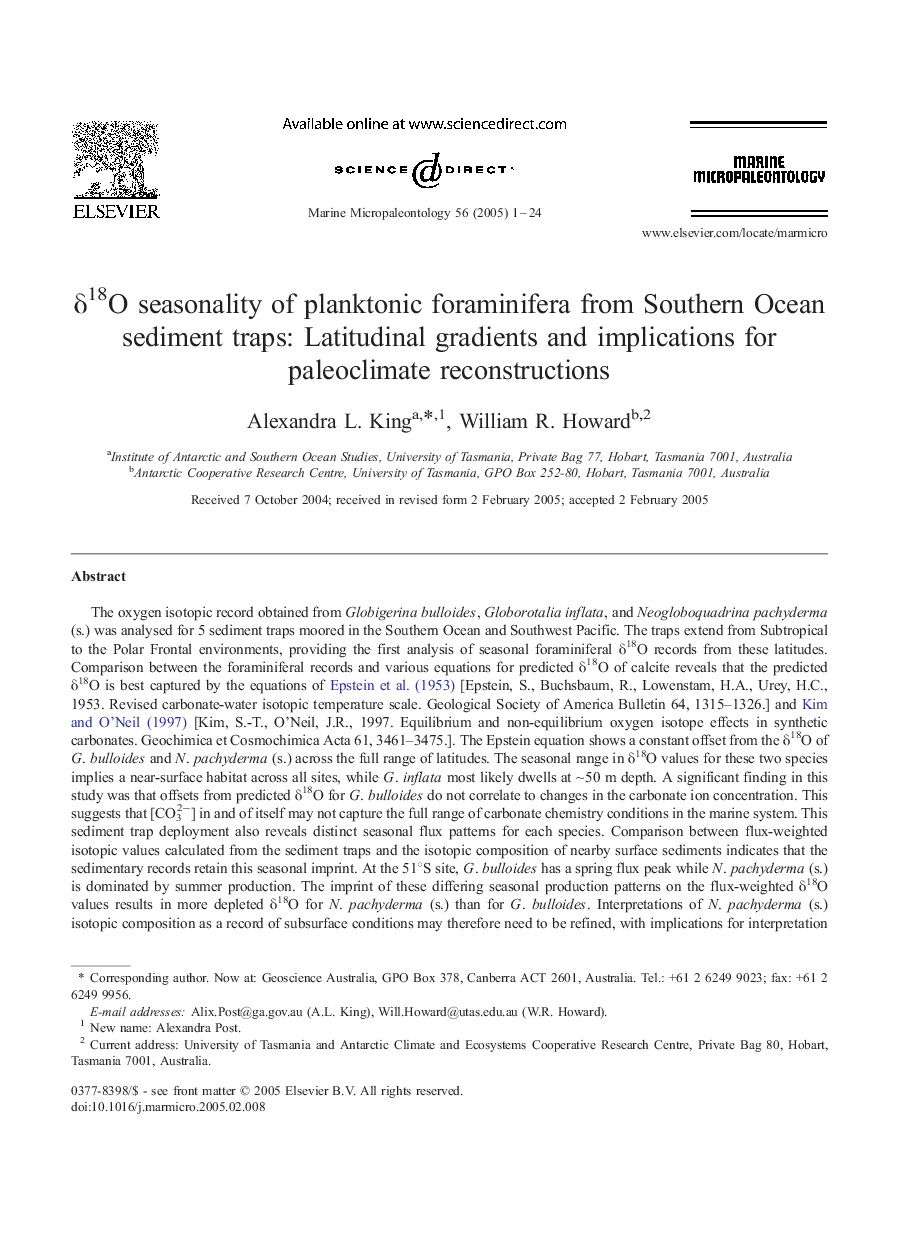| کد مقاله | کد نشریه | سال انتشار | مقاله انگلیسی | نسخه تمام متن |
|---|---|---|---|---|
| 9539676 | 1642237 | 2005 | 24 صفحه PDF | دانلود رایگان |
عنوان انگلیسی مقاله ISI
δ18O seasonality of planktonic foraminifera from Southern Ocean sediment traps: Latitudinal gradients and implications for paleoclimate reconstructions
دانلود مقاله + سفارش ترجمه
دانلود مقاله ISI انگلیسی
رایگان برای ایرانیان
کلمات کلیدی
موضوعات مرتبط
مهندسی و علوم پایه
علوم زمین و سیارات
فسیل شناسی
پیش نمایش صفحه اول مقاله

چکیده انگلیسی
The oxygen isotopic record obtained from Globigerina bulloides, Globorotalia inflata, and Neogloboquadrina pachyderma (s.) was analysed for 5 sediment traps moored in the Southern Ocean and Southwest Pacific. The traps extend from Subtropical to the Polar Frontal environments, providing the first analysis of seasonal foraminiferal δ18O records from these latitudes. Comparison between the foraminiferal records and various equations for predicted δ18O of calcite reveals that the predicted δ18O is best captured by the equations of Epstein et al. (1953) [Epstein, S., Buchsbaum, R., Lowenstam, H.A., Urey, H.C., 1953. Revised carbonate-water isotopic temperature scale. Geological Society of America Bulletin 64, 1315-1326.] and Kim and O'Neil (1997) [Kim, S.-T., O'Neil, J.R., 1997. Equilibrium and non-equilibrium oxygen isotope effects in synthetic carbonates. Geochimica et Cosmochimica Acta 61, 3461-3475.]. The Epstein equation shows a constant offset from the δ18O of G. bulloides and N. pachyderma (s.) across the full range of latitudes. The seasonal range in δ18O values for these two species implies a near-surface habitat across all sites, while G. inflata most likely dwells at â¼Â 50 m depth. A significant finding in this study was that offsets from predicted δ18O for G. bulloides do not correlate to changes in the carbonate ion concentration. This suggests that [CO32â] in and of itself may not capture the full range of carbonate chemistry conditions in the marine system. This sediment trap deployment also reveals distinct seasonal flux patterns for each species. Comparison between flux-weighted isotopic values calculated from the sediment traps and the isotopic composition of nearby surface sediments indicates that the sedimentary records retain this seasonal imprint. At the 51°S site, G. bulloides has a spring flux peak while N. pachyderma (s.) is dominated by summer production. The imprint of these differing seasonal production patterns on the flux-weighted δ18O values results in more depleted δ18O for N. pachyderma (s.) than for G. bulloides. Interpretations of N. pachyderma (s.) isotopic composition as a record of subsurface conditions may therefore need to be refined, with implications for interpretation of depleted glacial δ13C for this species (Sigman & Boyle, 2000) [Sigman, D.M., Boyle, E.A., 2000. Glacial/interglacial variations in atmospheric carbon dioxide. Nature 407, 859-869.].
ناشر
Database: Elsevier - ScienceDirect (ساینس دایرکت)
Journal: Marine Micropaleontology - Volume 56, Issues 1â2, July 2005, Pages 1-24
Journal: Marine Micropaleontology - Volume 56, Issues 1â2, July 2005, Pages 1-24
نویسندگان
Alexandra L. King, William R. Howard,